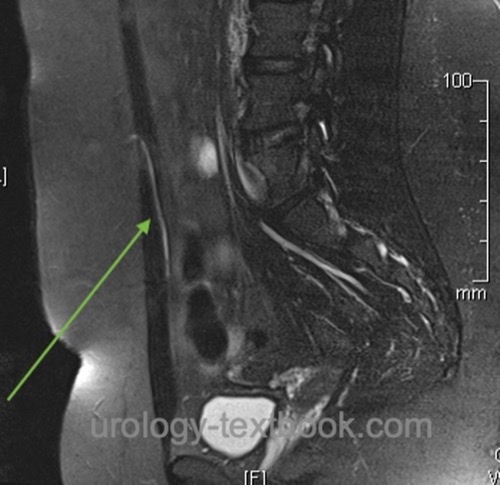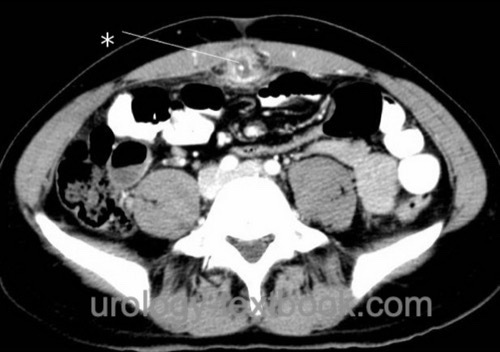You are here: Urology Textbook > Bladder > Urachal anomalies
Patent Urachus and Urachal Cysts: Diagnosis and Treatment
In fetal development, the bladder is connected via the urachus and umbilical cord to the allantois. Usually, the allantois obliterates, leaving the urachus as a fibrous strand at the anterior abdominal wall. Depending on the failure of the regression, various urachal remnants may persist [fig. patent urachus and urachal cysts].
 |
Epidemiology:
In children, the prevalence for sonographic abnormalities is approximately 1:500 (Keceli et al., 2021). The prevalence decreases with age, suggesting a marked spontaneous regression of urachal remnants.
Patent Urachus
A patent urachus leads to postpartum persistent loss of urine via the urachus at the umbilicus. Therapy consists of resection of the urachal fistula. Alternatively, a conservative attempt with bladder catheterization and waiting for spontaneous closure is possible (Lipskar et al., 2010).
Insufficient closure of the urachus:
If the urachus obliterates only at the level of the umbilicus, a vesicourachal diverticulum develops near the bladder apex. The vesicourachal diverticulum may lead to urinary tract infections and bladder stones. If the urachus obliterates only at the level of the bladder, an umbilical-urachus sinus develops with an opening at the umbilicus. The umbilical-urachus sinus causes continuous (purulent) draining [fig. mri of an umbilical-urachus sinus].
 |
Urachal cysts
A urachal cyst develops if the urachus obliterates at the level of the bladder and umbilicus but not in between. Urachal cysts may become symptomatic in adults with cyst infection [fig. superinfected urachal cyst] or as a palpable mass. The treatment of symptomatic urachal cysts consists of either percutaneous drainage or surgical (laparoscopic) cyst excision (Lipskar et al., 2010).
 |
Diagnosis of Urachal Remnants:
Ultrasound imaging, VCUG, MRI, cystoscopy.
Treatment
Surgical treatment is necessary only for symptomatic urachal remnants. The risk of developing a urachal carcinoma is considered very low (1:5000); this does not justify the prophylactic resection of visible urachal remnants (Gleason et al., 2015).
| Bladder physiology | Index | Bladder duplication |
Index: 1–9 A B C D E F G H I J K L M N O P Q R S T U V W X Y Z
References
J. M. Gleason et al., “A comprehensive review of pediatric urachal anomalies and predictive analysis for adult urachal adenocarcinoma.,” J Urol, vol. 193, no. 2, pp. 632–636, 2015.
Keç, “Are urachal remnants really rare in children? An observational study.,” Eur J Pediatr, vol. 180, no. 6, pp. 1987–1990, 2021.
Lipskar, A. M.; Glick, R. D.; Rosen, N. G.; Layliev, J.; Hong, A. R.; Dolgin, S. E. & Soffer, S. Z.
Nonoperative management of symptomatic urachal anomalies.
J Pediatr Surg, 2010, 45, 1016-1019
 Deutsche Version: Fehlbildungen des Urachus'
Deutsche Version: Fehlbildungen des Urachus'
Urology-Textbook.com – Choose the Ad-Free, Professional Resource
This website is designed for physicians and medical professionals. It presents diseases of the genital organs through detailed text and images. Some content may not be suitable for children or sensitive readers. Many illustrations are available exclusively to Steady members. Are you a physician and interested in supporting this project? Join Steady to unlock full access to all images and enjoy an ad-free experience. Try it free for 7 days—no obligation.
New release: The first edition of the Urology Textbook as an e-book—ideal for offline reading and quick reference. With over 1300 pages and hundreds of illustrations, it’s the perfect companion for residents and medical students. After your 7-day trial has ended, you will receive a download link for your exclusive e-book.